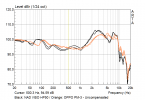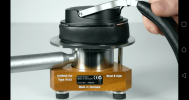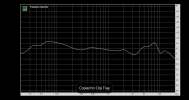Maiky76
Senior Member
This is a review and detailed measurements of the Oppo PM3 closed back planar magnetic headphone. It is on kind loan from a member. The PM3 is discontinued but seems to have quite a following and hence the reason I wanted to test it. Originally it cost US $399 but I see used prices from $500 up to $800. Typical of Oppo products, it holds its value well and even appreciates!
I am not a fan of the look of the cups but otherwise, there is a nice luxury feel and look to this headphone especially in white:
View attachment 144414
A 3.5 mm cable connects at both ends which is convenient. Note however that you need a slim fitting one at the headphone side. The cable supplied has a larger one at one end which would not fit right on the headphone until I reversed it.
The cups are small and I can feel them on my ears. The softness of the super supple pads help. Width and length of the cup inside dimensions are 60x40mm. Depth is 20mm.
Noise isolation is very good. It would block almost 80% of the noise from my Audio Precision's fan. Best noise cancelling headphones land at 95%+ and less good ones at 90% so this is very good.
Note: The measurements you are about to see are made using a standardized Gras 45C. Headphone measurements by definition are approximate and variable so don't be surprised if other measurements even if performed with the same fixtures as mine, differ in end results. Protocols vary such as headband pressure and averaging (which I don't do). As you will see, I confirm the approximate accuracy of the measurements using Equalization and listening tests. Ultimately headphone measurements are less exact than speakers mostly in bass and above a few kilohertz so keep that in mind as you read these tests. If you think you have an exact idea of a headphone performance, you are likely wrong!
Fitment on the fixture was challenging even though the cups easily covered the artificial ear on my measurement fixture. This resulted in fairly large variations in bass response. I got the two channels to match which is a good sign but still, keep in mind the cautions above in bold.
Oppo PM3 Measurements
As usual we start with the headphone frequency response as comparison to our preference curve:
View attachment 144415
First thing that stands out is the hump between 60 and 300 Hz. Other measurements show it less pronounced. And if I lowered the levels, I could make it less so even here. Listening tests have to confirm whether it is this exaggerated or not. Below and above this hump, we have surprisingly good compliance with our target. Response is "dirty" however with a number of kinks, likely caused by resonances. We have a bit of deficiency between 3 and 4 kHz and exaggerated peak around 7 to 8 kHz. Overall, this is not half bad.
Here is the relative response for equalization purposes:
View attachment 144416
Distortion is exceptionally low at bass frequencies especially as we consider that we already have enough or even too much energy there:
View attachment 144417
Unfortunately there are a lot of resonant peaks in higher frequencies. These could be the driver, the enclosure, or both. If you go back to the frequency response measurements, you can see traces of the same there.
Here it is in absolute log form:
View attachment 144418
Group delay doesn't tell us much except maybe confirming a resonance around 2 kHz:
View attachment 144419
Impedance is flat and low like most planar magnetics:
View attachment 144420
Sensitivity is above average so should not be hard to drive:
View attachment 144421
Oppo PM3 Listening Tests and Equalization
Some people accuse me of liking "bass." There is no better proof of this being wrong than me saying I did not at all like the bass response in the PM3. It is bloated. What I like is sub-bass response where there is almost never too much of a good thing.What is here is way too much and too high of a frequency which overwhems the tonality of the rest of the headphone. Add to that the lack of lower treble energy and the sound is not to my liking at all. Everything you play has some amount of "hmmmm" bass to it, whether it should or not.
So I pulled out the EQ and went after the three area of concern:
View attachment 144422
Once again I used dual filters to shape the response for bass (and amounts visually adjusted and hence the fractions). Measurements were correct in the level and magnitude of bass error. With this correct, deep bass is now a delight and the rest of the tonality gets to shine, well with the addition of the two filters.
Spatial qualities are good post EQ. I give it B+.
I am still listening them as I type this -- a sign of being happy with the sound of the headphone.
Conclusions
It is always nice to test "iconic" products and the Oppo PM3 is one. I can see some of the appeal it has in compliance with the Harman target in sub-bass and midrange. Exceptionally low distortion in bass helps with the clarity and clean sound here. This said, I can't listen to it without EQ. There is just too much boominess and missed sparkle in the lower treble.
I am happy to recommend the Oppo PM3 with Equalization. It is a pass for me without but it is not offensive for every day listening like some headphones are.
----------
As always, questions, comments, recommendations, etc. are welcome.
Any donations are much appreciated using: https://www.audiosciencereview.com/forum/index.php?threads/how-to-support-audio-science-review.8150/
Hi,
Here are some thoughts about the EQ.
Notes about the EQ design:
- The average L/R is used to calculate the score.
- The resolution is 12 points per octave interpolated from the raw data (provided by @amirm)
- A Genetic Algorithm is used to optimize the EQ.
- The EQ Score is designed to MAXIMIZE the Score WHILE fitting the Harman target curve with a fixed complexity.
This will avoid weird results if one only optimizes for the Score.
It will probably flatten the Error regression doing so, the tonal balance should be more neutral. - The EQs are starting point and may require tuning (certainly at LF).
- The range around and above 10kHz is usually not EQed unless smooth enough to do so.
- I am using PEQ (PK) as from my experience the definition is more consistent across different DSP/platform implementations than shelves.
- With some HP/amp combo the boosts and preamp gain need to be carefully considered to avoid issues
- Not all units of the same products are made equal. The EQ is based on the measurements of a single unit.
- YMMV with regards to the very unit you are trying this EQ on.
I have generated one EQ, the APO config file is attached.
Score no EQ: 56.2
Score Armirm: 91.0
Score with EQ: 94.4
Code:
Oppo PM3 APO EQ Flat@HF 96000Hz
August022021-102518
Preamp: -3.5 dB
Filter 1: ON PK Fc 112.69 Hz Gain -5.20 dB Q 1.30
Filter 2: ON PK Fc 223.77 Hz Gain -3.94 dB Q 0.47
Filter 3: ON PK Fc 368.10 Hz Gain 3.87 dB Q 2.00
Filter 4: ON PK Fc 3259.44 Hz Gain 3.65 dB Q 1.99
Filter 5: ON PK Fc 7301.67 Hz Gain -5.39 dB Q 3.92Attachments
Last edited:



